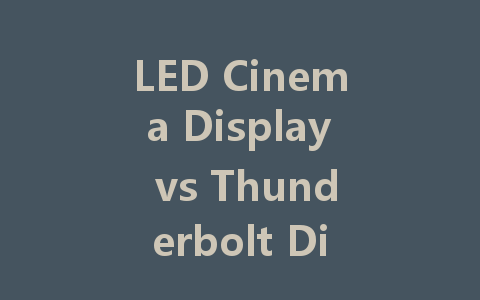
When it comes to choosing a monitor, two popular options that frequently come up in conversation are the LED Cinema Display and the Thunderbolt Display. Both are made by Apple and promise impressive visual performance, but they are designed for slightly different needs. In this article, we’ll take a closer look at these displays, comparing their specifications, features, and overall usability to help you determine which one might be the best fit for you.
Understanding the Displays
LED Cinema Display
The LED Cinema Display, first released in 2010, was Apple’s answer to providing an external monitor that would cater specifically to creatives. Designed with a sleek aluminum body, it boasts a 27-inch LED backlit display that offers a stunning resolution of 2560 x 1440 pixels. This monitor excels in providing beautiful color accuracy and wide viewing angles, making it ideal for video editing, graphic design, and photography.
Thunderbolt Display
The Thunderbolt Display, which also measures 27 inches, came onto the scene a couple of years later and offers similar visual qualities but with significant improvements. With a resolution of 2560 x 1440 pixels, it provides a pristine image quality. The major differentiating factor here falls with the Thunderbolt connection, which allows for faster data transfer and the ability to connect multiple devices easily via a single cable.
Key Features Comparison
Connectivity Options
One of the main advantages of the Thunderbolt Display is its connectivity. It features a Single Thunderbolt port, which supports high-speed data transfer rates. The Thunderbolt Display also includes three USB 2.0 ports, a FireWire 800 port, and a Gigabit Ethernet port.
On the other hand, the LED Cinema Display uses a DisplayPort connection and has fewer ports. It comes with two USB 2.0 ports and lacks several of the additional connections found in the Thunderbolt Display. If you frequently connect multiple devices or external peripherals, the Thunderbolt Display clearly has an edge in this category.
Performance
When it comes to performance, both displays deliver striking image quality and vibrant colors. However, the Thunderbolt Display edges ahead thanks to its higher bandwidth capabilities. This advantage becomes particularly noticeable when dealing with large files, intricate graphics, or when utilizing advanced applications such as 3D rendering software.
For regular users who primarily use their monitors for web browsing or document editing, the differences between the two may not be significant enough to warrant a switch.
Design and Usability
Aesthetic Appeal
Both displays feature Apple’s iconic design, featuring an aluminum casing and a gorgeous edge-to-edge glass panel that complements most workspaces elegantly. The LED Cinema Display has a thinner profile compared to its Thunderbolt counterpart but both are impressively sleek and stylish.
Ergonomics
The stands of both displays are adjustable, allowing users to tilt the screen for better viewing angles. However, users looking for height adjustability may be disappointed as neither model offers the flexibility to change the height of the display. They both support VESA mounting options, but this requires additional hardware.
Price Factor
As of the latest updates, prices can vary depending on availability and condition (especially for used models). Generally speaking, the Thunderbolt Display is priced slightly higher than the LED Cinema Display due to its enhanced performance capabilities and connectivity options. If you’re working with a strict budget, assessing your specific needs can help you decide which option offers the most value for you.
Conclusion: Which Is Right for You?
When deciding between the LED Cinema Display and the Thunderbolt Display, consider your primary use case. If you’re a creative professional working with high-resolution videos or graphics and need to manage several devices, the Thunderbolt Display is likely the better option due to its superior connectivity and performance.
However, if the primary use of your monitor is for browsing, office tasks, or casual use, the LED Cinema Display remains a viable and stylish choice. Ultimately, your decision will likely come down to your specific needs, work style, and budget.
Both displays reflect the quality and design philosophy Apple is known for, ensuring that whichever you choose, you’re investing in a reliable product that delivers a great viewing experience.